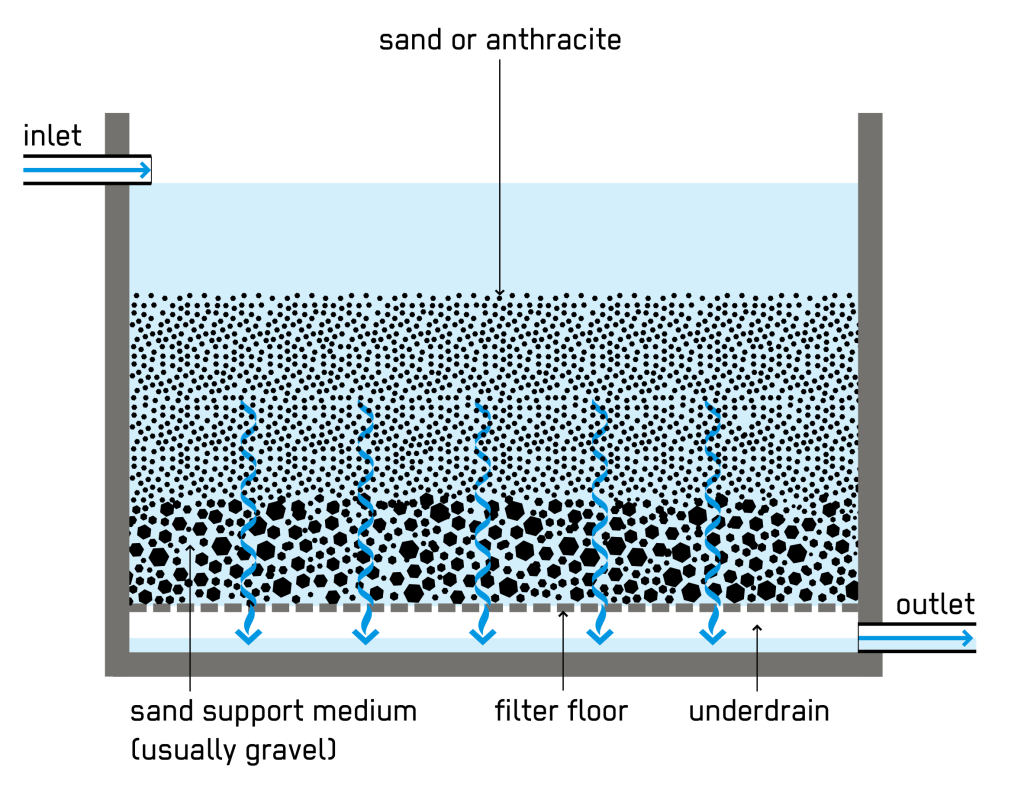5.3.3 Tertiary Filtration
Tertiary filtration in the forms of gravel and slow sand filtration may be the only cost-effective technologies to achieve pathogen removal in some circumstances. These systems can be very effective depending on flow rates, media size, uniformity, and filter bed depth.
Slow sand filters (SSF) are characterised by low flow rates, long retention times and fine sand as the filter medium. Before chlorination was a common practice, slow sand filtration was exercised to tackle the occurrence of waterborne diseases. If properly operated and following adequate pre-treatment, an SSF can remove 99% or more of the E. coli population. Subsequently, after SSF, discharge or reuse is possible.
To operate according to its design, an SSF needs to mature for a few weeks and establish the top biological layer in which micro-biological action takes place. During this period, the filtration system cannot assure pathogen removal. During the start-up phase, chloride should be added to the effluent after passing through the sand filter to ensure that the micro-biological active top layer remains intact. Once operating properly, chlorination is no longer a requirement unless the final purpose of the effluent requires it.
When in operation, the inflow of an SSF is advised never to be completely stopped to avoid the drying of the top layer, which would require it to be re-established. This will impair bacteriological purification. Instead, an inflow of 0.02 m3/m2/h is recommended to be ensured even during maintenance works and during night times or other downtimes. Following removal of the accumulated top layer (complete removal should be avoided), the filter requires some time for recovery. Flow rates between 0.1 – 0.3 m3/m2/h are recommended in normal operation.
The supernatant of the SSF can comprise a layer of up to 1.5 m. In this supernatant layer, algae may grow. In moderate quantities, algae can be beneficial for the functioning. But in case of massive growth, the permeability of the filtering bed may be reduced significantly, also reducing the overall efficiency of the filter. Extensive algae growth may create odours and contribute to microbial growth in the evacuation piping network. Algae growth should, therefore, be controlled, e.g. by covering the filter bed to exclude sunlight or by adopting appropriate maintenance procedures.
An area of 10 m2 per m3 of wastewater per day is recommended for efficient treatment.
The following table outlines the advantages and disadvantages of slow sand filters for tertiary filtration.
| Advantages | Disadvantages |
|---|---|
| Has low operational costs | Requires longer start-up time and time to recover after maintenance works |
| Requires no energy supply | Has comparatively low flow rates |
| Can be constructed with local resources | Needs proper design, operation, and careful monitoring (especially of the biological top layer) to ensure treatment efficiency |
| No need for backwashing | Has a risk of algae growth |
| Good efficiency in pathogen removal |
Alternatively, to sand, activated carbon can be used as a filter medium. In this case, the dominating process is adsorption. Activated carbon adsorbers not only remove a variety of organic and inorganic compounds, but they also eliminate taste and odour.

Another option comparable to tertiary filtration is direct infiltration into the soil, further explained in module 8.
For further information, please click on the Materials tab at the top of the page.
Further Reading:
- Design Manual – Municipal Wastewater Disinfection (EPA, 1986): Presentation of different disinfection methods and guidance for the implementation of these different methods. (Link)
- Tertiary Filtration and Disinfection (Emerson Compendium): General overview on tertiary filtration and disinfection. (Link)
